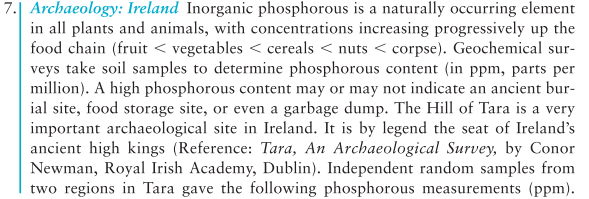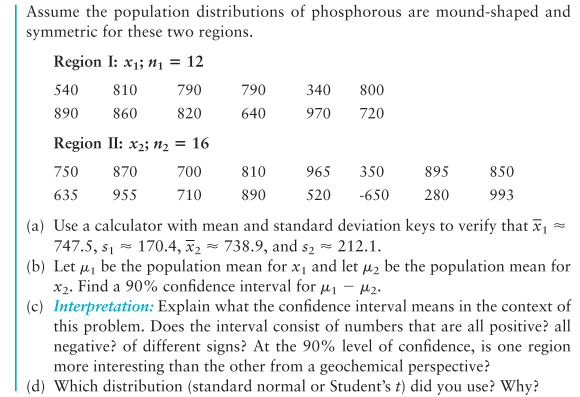7. Archaeology: Ireland Inorganic phosphorous is a naturally occurring element in all plants and animals, with concentrations increasing progressively up the food chain (fruit < vegetables < cereals < nuts < corpse). Geochemical sur- veys take soil samples to determine phosphorous content (in ppm, parts per million). A high phosphorous content may or may not indicate an ancient bur- ial site, food storage site, or even a garbage dump. The Hill of Tara is a very important archaeological site in Ireland. It is by legend the seat of Ireland's ancient high kings (Reference: Tara, An Archaeological Survey, by Conor Newman, Royal Irish Academy, Dublin). Independent random samples from two regions in Tara gave the following phosphorous measurements (ppm). Assume the population distributions of phosphorous are mound-shaped and symmetric for these two regions. Region I: x1; n1 = 12 540 810 790 790 340 800 890 860 820 640 970 720 Region II: x2; n2 = 16 750 870 700 810 965 350 895 850 635 955 710 890 520 -650 280 993 (a) Use a calculator with mean and standard deviation keys to verify that x1 747.5, s1 - 170.4, x2 - 738.9, and s2 - 212.1. (b) Let u, be the population mean for x1 and let u2 be the population mean for x2. Find a 90% confidence interval for u1 – 42. (c) Interpretation: Explain what the confidence interval means in the context of this problem. Does the interval consist of numbers that are all positive? all negative? of different signs? At the 90% level of confidence, is one region more interesting than the other from a geochemical perspective? (d) Which distribution (standard normal or Student's t) did you use? Why?
7. Archaeology: Ireland Inorganic phosphorous is a naturally occurring element in all plants and animals, with concentrations increasing progressively up the food chain (fruit < vegetables < cereals < nuts < corpse). Geochemical sur- veys take soil samples to determine phosphorous content (in ppm, parts per million). A high phosphorous content may or may not indicate an ancient bur- ial site, food storage site, or even a garbage dump. The Hill of Tara is a very important archaeological site in Ireland. It is by legend the seat of Ireland's ancient high kings (Reference: Tara, An Archaeological Survey, by Conor Newman, Royal Irish Academy, Dublin). Independent random samples from two regions in Tara gave the following phosphorous measurements (ppm). Assume the population distributions of phosphorous are mound-shaped and symmetric for these two regions. Region I: x1; n1 = 12 540 810 790 790 340 800 890 860 820 640 970 720 Region II: x2; n2 = 16 750 870 700 810 965 350 895 850 635 955 710 890 520 -650 280 993 (a) Use a calculator with mean and standard deviation keys to verify that x1 747.5, s1 - 170.4, x2 - 738.9, and s2 - 212.1. (b) Let u, be the population mean for x1 and let u2 be the population mean for x2. Find a 90% confidence interval for u1 – 42. (c) Interpretation: Explain what the confidence interval means in the context of this problem. Does the interval consist of numbers that are all positive? all negative? of different signs? At the 90% level of confidence, is one region more interesting than the other from a geochemical perspective? (d) Which distribution (standard normal or Student's t) did you use? Why?
Linear Algebra: A Modern Introduction
4th Edition
ISBN:9781285463247
Author:David Poole
Publisher:David Poole
Chapter2: Systems Of Linear Equations
Section2.4: Applications
Problem 28EQ
Related questions
Question

Transcribed Image Text:7. Archaeology: Ireland Inorganic phosphorous is a naturally occurring element
in all plants and animals, with concentrations increasing progressively up the
food chain (fruit < vegetables < cereals < nuts < corpse). Geochemical sur-
veys take soil samples to determine phosphorous content (in ppm, parts per
million). A high phosphorous content may or may not indicate an ancient bur-
ial site, food storage site, or even a garbage dump. The Hill of Tara is a very
important archaeological site in Ireland. It is by legend the seat of Ireland's
ancient high kings (Reference: Tara, An Archaeological Survey, by Conor
Newman, Royal Irish Academy, Dublin). Independent random samples from
two regions in Tara gave the following phosphorous measurements (ppm).

Transcribed Image Text:Assume the population distributions of phosphorous are mound-shaped and
symmetric for these two regions.
Region I: x1; n1 = 12
540
810
790
790
340
800
890
860
820
640
970
720
Region II: x2; n2 = 16
750
870
700
810
965
350
895
850
635
955
710
890
520
-650
280
993
(a) Use a calculator with mean and standard deviation keys to verify that x1
747.5, s1 - 170.4, x2 - 738.9, and s2 - 212.1.
(b) Let u, be the population mean for x1 and let u2 be the population mean for
x2. Find a 90% confidence interval for u1 – 42.
(c) Interpretation: Explain what the confidence interval means in the context of
this problem. Does the interval consist of numbers that are all positive? all
negative? of different signs? At the 90% level of confidence, is one region
more interesting than the other from a geochemical perspective?
(d) Which distribution (standard normal or Student's t) did you use? Why?
Expert Solution
This question has been solved!
Explore an expertly crafted, step-by-step solution for a thorough understanding of key concepts.
This is a popular solution!
Trending now
This is a popular solution!
Step by step
Solved in 2 steps with 1 images

Recommended textbooks for you

Linear Algebra: A Modern Introduction
Algebra
ISBN:
9781285463247
Author:
David Poole
Publisher:
Cengage Learning

Algebra for College Students
Algebra
ISBN:
9781285195780
Author:
Jerome E. Kaufmann, Karen L. Schwitters
Publisher:
Cengage Learning

Linear Algebra: A Modern Introduction
Algebra
ISBN:
9781285463247
Author:
David Poole
Publisher:
Cengage Learning

Algebra for College Students
Algebra
ISBN:
9781285195780
Author:
Jerome E. Kaufmann, Karen L. Schwitters
Publisher:
Cengage Learning